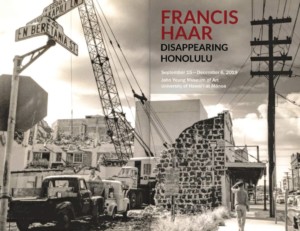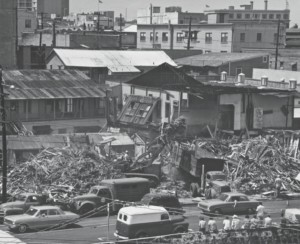
Front cover of the Francis Haar: Disappearing Honolulu exhibit brochure4/30/20: A Preservation Award in Interpretive Media will recognize Francis Haar: Disappearing Honolulu, an exhibit last fall consisting of a film and photographs at the John Young Museum of Art – University of Hawai‘i at Manoa.
In the words of exhibit curator Gaye Chan, “Haar’s photographs and film are valuable documents of a not-so-distant past that capture one of Honolulu’s diverse communities in the midst of urban displacement — a theme that remains relevant today as Honolulu undergoes another period of transformation”.
In the early 1960s, Hawai‘i had completed urban renewal designation and procedures that would demolish 75 acres encompassing the A‘ala Triangle and areas mauka of North Beretania Street. The redevelopment was named the Kukui District Urban Renewal Project.
With demolition scheduled to start in January 1965, a trio rushed to capture on film the community of A‘ala, which until December 1941 had been the center of Honolulu’s Japanese residential community, businesses, and venues for entertainment. The trio was Stephen Bartlett, planner and reporter, Kenneth Bushnell, artist and teacher with a studio on the second floor of the iconic A‘ala Pawn Shop building, and Francis Haar, a photographer and creator of documentaries.
They began their filming and documentation in November 1964 and continued through mid-January of the following year. However, due to a shortage of funding, the film was not finished until 1968. As Francis’ son, Tom recounted, “They applied for a grant to then Hawai‘i Governor John Burns who turned them down with a cynical reply as to ‘who would be interested to document this flea-infested section of old Honolulu?’”
“It is a fantastic film,” said Chan, “of a style that was used in many experimental films. Non-narrative, non-linear, with audio purposefully not aligned with the visual. I particularly like its editing.”
Maika Pollack, director of the John Young Museum of Art, remarked in the exhibit’s brochure, “His (Haar’s) images show the beauty and cultural vibrancy of a ‘flea-infested section of old Honolulu,’ before it would be forever altered.”
Francis Haar and his family moved to Hawai‘i in 1960. He was born in 1908 in Hungary, studied to be an architect and began working in that profession, while developing a special interest in photography. In Budapest in his twenties he was influenced by socialist avant-garde artists and writers who were concerned about the plight of workers in an industrializing world. Francis would enter his work in exhibits devoted to socio-photography.
After his work was successfully included in a French exhibition, he moved to Paris in 1937 with his wife Irene. With WWII looming, he accepted an invitation to relocate to Tokyo in 1939 where he opened a photo studio. He stayed there through the war and barely survived, malnourished and bedridden.
After the war, the Haars stayed in Tokyo until 1960 with Irene opening a Hungarian restaurant and Francis immersed in photography, while also publishing books on Japan and Japanese art, and creating documentary films about Japan.
He first came to Hawai‘i in 1959 while working on a documentary for the Art Institute of Chicago about ukiyo-e, Japanese wood block prints. The trip was to interview James A. Michener about his vast collection of ukiyo-e which was later donated to the Honolulu Museum of Art. The time he spent here convinced Francis to move with his family to the Islands.
This link will take you to the John Young Museum of Art webpage for the exhibit with its links to the Exhibit Brochure, the Haar photos in the exhibit, and the film A‘ala – Life and Death of a Community.
The Preservation Award will be presented to Gaye Chan, Lorraine Minatoishi, Malia Van Heukelem, Maika Pollack, Tom Haar, Ian Lind, and Don Hibbard.
The 46th Annual Preservation Honor Awards Ceremony was originally scheduled to be held in May 2020. However, the current public health crisis caused by COVID-19 has resulted in postponement of the public event. A new date will be selected and notices sent at a later date.
By John Williams, Preservation Honor Awards Project Manager.




